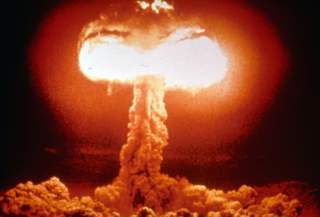Why Putin's Nuclear Cruise Missile Could Entangle the World in a Nuclear War
How scared should we actually be?
We can't know for sure what was on Vladimir Putin's mind last week when he boasted of Russia developing an “invincible” nuclear-powered cruise missile, a nuclear torpedo and other strategic weapons. Perhaps he thought he was asserting Moscow's power against Washington, or deterring a perceived American threat. Or maybe he was trying to talk up Russia's martial prowess.
But one thing he certainly did not intend was to increase the chances of a nuclear war. It's not the weapons that are the issue: Western experts deride a nuclear-powered cruise missile as an atomic Edsel, a failed concept that Americans and Soviets dropped in the 1950s.
The problem is what is called “nuclear entanglement,” when the lines between conventional and nuclear weapons become blurred. When you have a missile that can carry conventional or nuclear warheads, and the other side can't be sure which kind the rocket is carrying, that's entanglement. When conventional and nuclear forces are located in the same area, so that an attack on regular troops can be mistaken for a first strike aimed at destroying a nation's nuclear deterrent, that's also entanglement.
Recommended: Stealth vs. North Korea’s Air Defenses: Who Wins?
Recommended: America’s Battleships Went to War Against North Korea
Recommended: 5 Places World War III Could Start in 2018
During the Cold War, the prospect of nuclear Armageddon was more ominous, but also more straightforward. Destroying the other superpower's nuclear missiles in their hardened silos meant landing a nuclear warhead on top of them. But a new generation of fast, stealthy, hard-to-shoot-down conventional weapons, such as hypersonic cruise missiles traveling at faster than Mach 5, are more than just devastating battlefield weapons. They raise the specter of a surprise attack using nonnuclear weapons an opponent's nuclear strike force.
These new conventional weapons actually increase the chances of nuclear war, says arms control expert James Acton, co-director of the Nuclear Policy Program at the Carnegie Foundation for International Peace. Acton, along with Russian and Chinese experts, authored a report late last year on nuclear entanglement.
Whether any nation would risk nuclear war by going after an opponent's strategic weapons is a valid question. But so is this: how many leaders want to be the first to employ nuclear weapons in response to a conventional attack? Already many Americans are grumbling over the Trump administration's draft nuclear policy, which suggests that the United States might respond with nukes to a cyberattack or an attack on American satellites.
Russia is certainly concerned about this, which helps explain Putin's boast of developing new strategic weapons. “An enduring concern among Russia’s leadership is the threat of a massive disarming strike using non-nuclear high-precision weapons,” according to the Carnegie report. “In a non-nuclear conflict, U.S. strikes might inadvertently spark concern that such a counterforce attack was under way. For example, because strategic submarines and bombers are kept at the same bases as general- purpose naval vessels and aircraft, strikes designed to target the latter might unintentionally destroy the former.”
The report focused on how Russia and China treat nuclear war differently than the United States, including entangling nuclear and nonnuclear forces. While Russia’s mingling of nuclear and conventional forces might seem appropriate to planners in Moscow, it creates a dilemma for Washington—targeting regular Russian troops can now be perceived as a nuclear threat.
Issues such as whether an attack on early warning satellites is a casus belli is as much cultural as military. For example, while the Trump administration views targeting satellites as an existential threat that could merit a nuclear response, China does not see this the same way.
“Some Chinese analysts, especially those arguing for the use of anti-satellite weapons in a limited regional war against the United States, tend to view the thickened fog of war that would result from such strikes as a tactical military advantage for China,” says the Carnegie report. “Another consequence, however, is that the United States might misinterpret Chinese military moves—such as exercises or the mobilization of missile forces—as preparations for actually using nuclear weapons.”
Acton recommends confidence-building measures in which the United States and Russia would agree not to mass cruise missiles within range of each other's strategic targets, prohibit testing of anti-satellite weapons, and include intercontinental boost-glide hypersonic weapons within the next strategic arms reduction treaty.
Michael Peck is a contributing writer for the National Interest. He can be found on Twitter and Facebook.
Image: Wikimedia Commons

